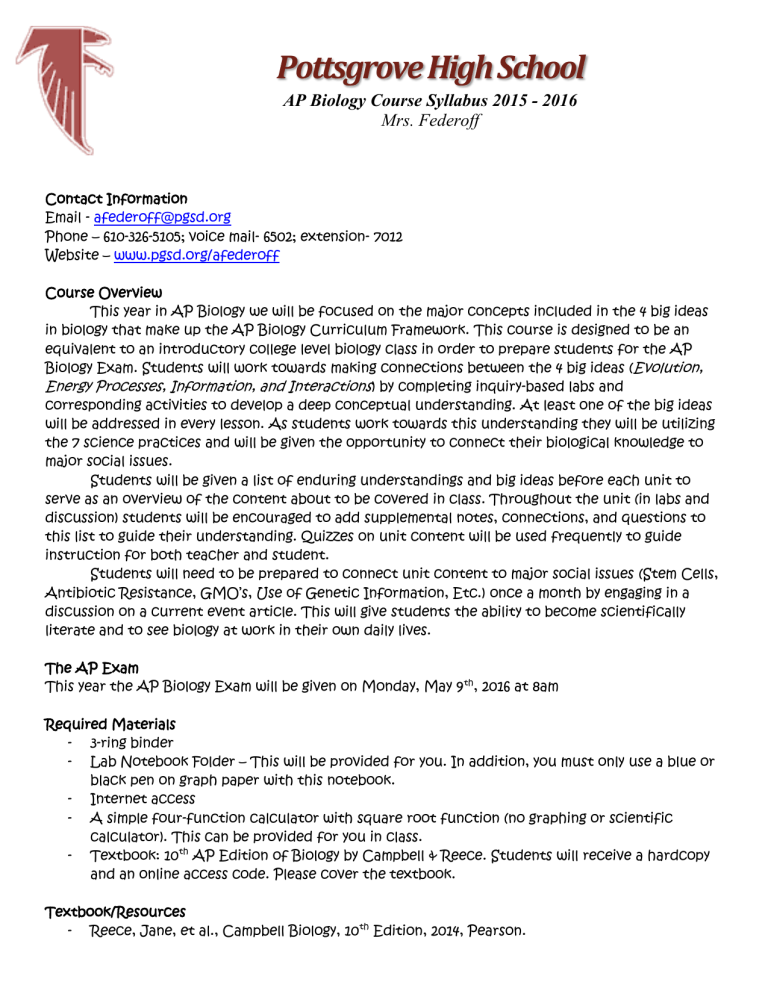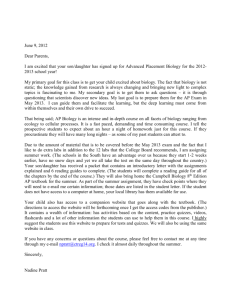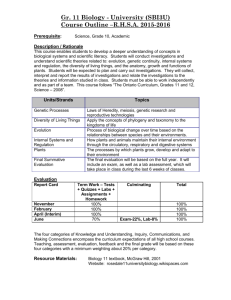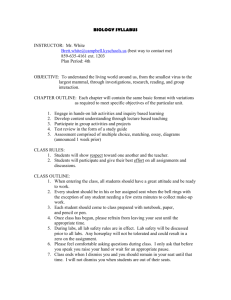AP Biology Syllabus 2015-2016

Pottsgrove High School
AP Biology Course Syllabus 2015 - 2016
Mrs. Federoff
Contact Information
Email - afederoff@pgsd.org
Phone – 610-326-5105; voice mail- 6502; extension- 7012
Website – www.pgsd.org/afederoff
Course Overview
This year in AP Biology we will be focused on the major concepts included in the 4 big ideas in biology that make up the AP Biology Curriculum Framework. This course is designed to be an equivalent to an introductory college level biology class in order to prepare students for the AP
Biology Exam. Students will work towards making connections between the 4 big ideas ( Evolution,
Energy Processes, Information, and Interactions ) by completing inquiry-based labs and corresponding activities to develop a deep conceptual understanding. At least one of the big ideas will be addressed in every lesson. As students work towards this understanding they will be utilizing the 7 science practices and will be given the opportunity to connect their biological knowledge to major social issues.
Students will be given a list of enduring understandings and big ideas before each unit to serve as an overview of the content about to be covered in class. Throughout the unit (in labs and discussion) students will be encouraged to add supplemental notes, connections, and questions to this list to guide their understanding. Quizzes on unit content will be used frequently to guide instruction for both teacher and student.
Students will need to be prepared to connect unit content to major social issues (Stem Cells,
Antibiotic Resistance, GMO’s, Use of Genetic Information, Etc.) once a month by engaging in a discussion on a current event article. This will give students the ability to become scientifically literate and to see biology at work in their own daily lives.
The AP Exam
This year the AP Biology Exam will be given on Monday, May 9 th , 2016 at 8am
Required Materials
3-ring binder
Lab Notebook Folder – This will be provided for you. In addition, you must only use a blue or black pen on graph paper with this notebook.
Internet access
A simple four-function calculator with square root function (no graphing or scientific calculator). This can be provided for you in class.
Textbook: 10 th AP Edition of Biology by Campbell & Reece. Students will receive a hardcopy and an online access code. Please cover the textbook.
Textbook/Resources
Reece, Jane, et al., Campbell Biology, 10 th Edition, 2014, Pearson.
AP Biology Investigative Labs: an Inquiry Based Approach , as well as other laboratory investigations (as deemed necessary).
Laboratory Investigations
The laboratory investigations in this course are centered on student directed lab practices and will make up at least 25% of this course. Our 8 laboratory investigations (2 for each big idea) will represent all four levels of inquiry to ensure student ownership on content material. Using inquiry labs, students will be actively engaged in the process of science, which increases their critical thinking and problem solving abilities. Labs emphasize the development and testing of a hypothesis, collection, analysis and presentation of data, as well as a discussion of results to reveal how error, next steps and unanswered questions. Additional supplemental labs will also be inquiry based to further enhance student understanding. Throughout these investigations students will utilize all 7science practices, and will use at least one science practice in each lab investigation. Following lab investigations lab reports, projects, posters and abstracts will be completed to allow students to develop, record and communicate their findings.
Assessments
Tests – There will be one test for each unit completed. Tests will be modeled on the AP exam and include multiple choice, mathematical “grid-in” questions, and constructed response questions.
Labs – You are required to compete every lab we conduct. These lab activities will be major, longterm experiences that will involve the development of a particular protocol to answer a question of your own creation, the collection of data and the generation and publishing of a documentation of your lab experiences (typically a lab report, or a presentation)
Quizzes – will be announced and unannounced. Many will cover content from reading homework assignments. This is to check understanding and make sure students are keeping up with the material.
General Assignments – All other work that is done in this class falls into this general category.
These are not always graded, but feedback will be provided.
Missing Work: It is strongly recommended that you attend class every day in a timely fashion.
Excessive lateness or absences will make it very difficult for you to keep up with the workload of this course. If you are absent, it is your responsibility to makeup all assignments. “I was absent” is not an excuse for missing an assignment (unless I excuse you). All assignments are posted on the class calendar, which is accessible from all course websites. Please discuss missed work with me as soon as you return to class. Work done during absences is due one day after your return to class.
You must also make arrangements to makeup any labs, quizzes or tests as soon as you return to school.
Study Tips – A note about the Exams
The AP Biology exam will assess your ability to think like a scientist, along with your understanding of the course content (what’s in the textbook). This will also be true of any in-class assessments, and
many of the in- class projects. To that end, there will be situations and content on exams that will not be specifically discussed in class prior to their appearance on exams. This is may be very different than many other types of courses you might have taken.
A good rule of thumb is that any content covered in the material you are responsible for reading/viewing/watching in the content homework could appear on an exam, regardless of whether or not we have discussed it specifically in class. The take-home message for you is that independent reading/viewing/watching is absolutely crucial, and must be done if you want to succeed.
Grading Policy
90% - Demonstrating Knowledge (tests, quizzes, projects )
10%- Building Knowledge (Homework, Classwork, and lab reports)
Homework – It is important students complete homework on time in order to build their knowledge. If a homework assignment is late 10% will be deducted for each day. Students will not have the opportunity to submit late homework for credit once answers have been reviewed in class.
Assessment – Unit tests and projects are key summative assessments. All final unit assessments must be taken in the order assigned. If a student fails to complete the final unit assessment before the end of the next unit, the student will receive
70% of the earned grade once its completed. Failure to complete an assessment
will result in an incomplete for the marking period. Students will have two weeks to complete the assessment.
The Big Ideas
Each Big Idea from the College Board is broken down into Enduring Understandings, Essential
Knowledge and Learning Objectives
Science Practices
As an AP Biology student you are expected to demonstrate competence in science practices that scientists engage in. Which include:
1.
The student can use representations and models to communicate scientific phenomena and solve scientific problems.
2.
The student can use mathematics appropriately.
3.
The student can engage in scientific questioning to extend thinking or to guide investigations within the context of the AP course.
4.
The student can plan and implement data collection strategies appropriate to a particular scientific question.
5.
The student can perform data analysis and evaluation of evidence.
6.
The student can work with scientific explanations and theories.
7.
The student is able to connect and relate knowledge across various scales, concepts and representations in and across domains.
Unit Topic
Units of Instruction
Discussion Topics
Unit 1 - The
Chemistry of Life
& Introduction
BIG IDEAS:
Evolution, Energy,
Interactions
Unit 2 - Evolution
BIG IDEAS:
Evolution,
Information,
Interactions
1.
Introduction to the four big ideas and enduring understandings
2.
The Science Process Reviewed
3.
Emergent Properties of Water
4.
The Impact of Carbon as the “Backbone of Life”
5.
Monomers Making Polymers
1.
How natural selection serves as a mechanisms for evolution
2.
Scientific evidence supporting evolution
3.
Hardy-Weinberg concept
4.
How allele frequencies can be altered in a population
5.
Concepts of speciation
6.
Origin of Life; Fossil Records
7.
Events in the “history of life” (origin of single-celled and multicellular organisms; mass extinctions; adaptive radiations)
Unit 3 - The Cell
BIG IDEAS:
Evolution, Energy,
Information,
Interactions
1.
2.
Examples of organelles that are membrane bound to compartmentalize their functions.
Membrane structure and function.
Unit 4 - Cellular
Energy
BIG IDEAS:
Energy,
Information,
Interactions
1.
An Introduction to Metabolism
2.
Laws of Energy Transformations
3.
How ATP powers cellular work
4.
Enzyme structure and function
5.
Harvesting chemical energy: glycolysis, citric acid cycle, oxidative phosphorylation
6.
Light reactions and the Calvin Cycle
7.
Evolution of alternative mechanisms of carbon fixation
Unit 5 - Cell
Communication &
The Cell Cycle
1.
Evolution of cell signaling
2.
Reception, transduction, response
3.
4.
Apoptosis
How mitosis produces genetically identical daughter cells
BIG IDEAS:
Evolution, Energy,
Information
5.
6.
Evolution of Mitosis
How the eukaryotic cell cycle is regulated by a molecular control system
7.
Origin of cell communication
Unit 6 - Genetic 1.
Genes are passed form parents to offspring by the
Chps
1-5
22-25
6-7
8-10
11-12
13-15
Labs
AP Lab 12 – Animal
Behavior
Water Lab
AP Lab 1 –
Artificial Selection
AP Lab 3 – BLAST
Strawfish & Hardy-
Weinberg
AP Lab 4 -
Diffusion and
Osmosis
Microscope Lab
AP Lab 13 - Enzyme
Catalysis
AP Lab 5 -
Photosynthesis
AP Lab 6 – Cellular
Respiration
AP Lab 7 – Cell
Division: Mitosis and Meiosis
Genetics of
Basis of Life
BIG IDEAS:
Evolution,
Information,
Interactions
Unit 7 - Gene
Activity &
Biotechnology
BIG IDEAS:
Evolution, Energy,
Information,
Interactions
Unit 8 - Biological
Diversity
BIG IDEAS:
Evolution, inheritance of chromosomes
2.
How meiosis reduces the number of chromosomes
(diploid to haploid)
3.
Evolutionary significance of genetic variation that results from sexual life cycles
4.
Concepts of Mendelian genetics (laws of probability, inheritance patterns)
5.
Genes are located along chromosomes (concepts of gene linkage, mapping distance between genes, causes of genetic disorders)
1.
DNA is the genetic material (historical experiments,
DNA structure and function, DNA replication)
2.
Flow of genetic information (genetic code, role of other polymers, transcription, translation)
3.
Mutations
4.
Gene Expression
5.
Virus structure and activity
6.
Restriction enzymes, plasmids and transformation
7.
DNA technology (how gel electrophoresis works and application of this technology)
1.
Phylogenetics
2.
Cladograms
Unit 9 - Form and
Function (Plants and Animals)
BIG IDEAS:
Evolution, Energy,
Information,
Interactions
Unit 10 - Ecology
BIG IDEAS:
Evolution, Energy,
Information,
1.
Evolutionary trends (endosymbiosis, adaptations that allowed plants to move form water to land, reproductive adaptations of angiosperms, environmental roles of fungi, animal body plans, progressively complex derived characters in animal groups)
2.
Unique features of the angiosperm life cycles
3.
Signal transduction pathways (animal and plant hormones)
4.
Phototropism in plants
5.
Feedback control loops in animals
6.
Thermoregulation in animals
7.
Energy allocation and use in animals
8.
Examples of functioning units in mammal systems
(alveoli in lungs, villi of small intestines, nephrons in kidneys)
9.
Structure and function in nervous systems (neurons, resting potential, action potential, synapses)
10.
Structure and function of the human brain
1.
Aspects of animal behavior
2.
Aspects of biomes
3.
Models describing population growth
4.
Regulation of population growth
5.
Community interactions
16-21
26-34
35-39
51-56
Drosophila
AP Lab 8 – Bacterial
Transformation
Biotechnology
Restriction Enzymes
Phlyogenetics
Cladogram
Construction
Organism response to stimuli
Food Webs &
Biological
Magnification
Interactions 6.
Species diversity and composition
7.
Community biodiversity
8.
Energy flow and chemical cycling in ecosystems
9.
Primary productivity
10.
Energy transfer between trophic levels
11.
Human activities that threaten biodiversity
12.




